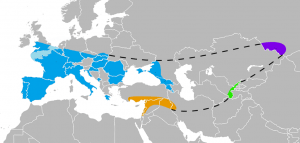What happens if a Neanderthal bites you?
By Josie Mills, on 3 July 2018
Neanderthals have a pretty robust bone structure in comparison to anatomically modern humans and the differences in facial bone structure are particularly striking. In the image below, you can see several of these features, like the high domed cranium and distinctive occipital bun (the pinching at the rear of the skull). To the front of the skull you might notice the large nasal aperture (hole from nose into head) and heavy brow ridge. They also have an extremely strong looking jaw!
It’s likely that these skeletal features are linked to some sort of adaptive process and three main theories are that they give Neanderthals:
1.) A stronger biting force.
2.) The ability to process large amounts of air quickly.
3.) More efficient survival in cold climates with dry air.

When compared the skull and consequent brain size appears larger this probably didn’t make them smarter as intelligence is linked more to how the brain is folded ! Image credit: hairymuseummatt (original photo), DrMikeBaxter (derivative work) [CC BY-SA 2.0 (https://creativecommons.org/licenses/by-sa/2.0)], via Wikimedia Commons
Recent research by Wroe et al. (2018) aims to shed light on this debate. Researchers analysed the biomechanics of bite strength across different hominin species, focusing on Homo heidlbergensis, Homo neanderthalensis and Homo sapiens. They used CT-scans of multiple crania to establish the bite efficiency in the different hominins. The results suggested that Neanderthal bite strength was very similar to Homo sapiens and in fact anatomically modern humans could bite more efficiently using fewer muscles. The analysis also demonstrated that both species had nasal cavities that were adapted to condition air efficiently but Neanderthals could take significantly more air into their nasal pathway. Poor Heidlbergensis was the worst at everything… but that’s perhaps unsurprising as it is an older, less derived (evolved), member of the human lineage.
These results strongly support the theory that Neanderthals facial anatomy was adapted to high energy activity in cold, dry, climates. This makes sense in terms of the Neanderthal range and the fact that they evolved and lived outside of Africa. There is evidence of Neanderthal populations surviving during very cold periods of the Ice Age, for example at La Cotte de St. Brelade in Jersey. There are archaeological deposits from this site that date to Marine Isotope Stage 6 (between 191 – 130 thousand years ago), a time when cold conditions prevailed.
This new evidence also fits well with Neanderthal post-cranial adaptations like their large barrel shaped rib cage and short, stocky, stature. These features may have helped to improve survival in cooler climes by aiding air processing and retention of body heat.

This figure shows known Neanderthal range, which demonstrates that although some liked it hot evidence of their presence has been found as far north as England and Russia . Image credit: Nicholas Perrault https://commons.wikimedia.org/wiki/File:Range_of_Homo_neanderthalensis.png
So, to answer the question: being bitten by a Neanderthal would probably hurt like hell but it would be marginally better than being bitten by an anatomically modern human…
References
Wroe, S., Parr, W. C. H., Ledogar, J. A., Bourke, J., Evans, S. P., Fiorenza, L., Benazzi, S., Hublin, J., Stringer, C., Kullmer, O., Curry, M., Rae, T. C., Yokley, T. R. 2018. Computer simulations show that Neanderthal facial morphology represents adaptation to cold and high energy demands, but not heavy biting. Proc. R. Soc. B 285: 20180085. http://dx.doi.org/10.1098/rspb.2018.0085
 Close
Close

